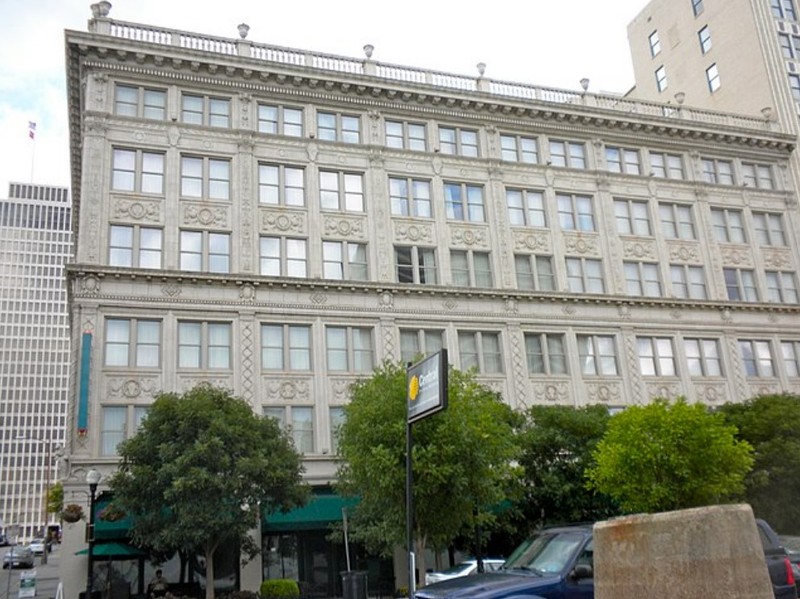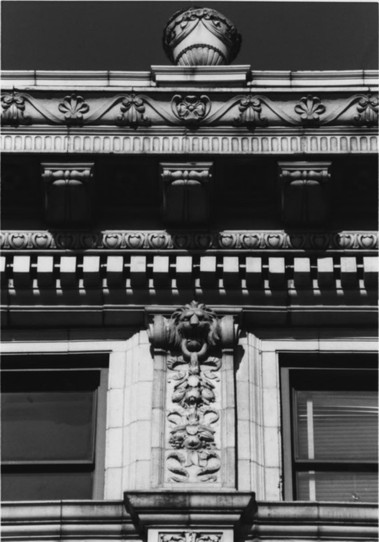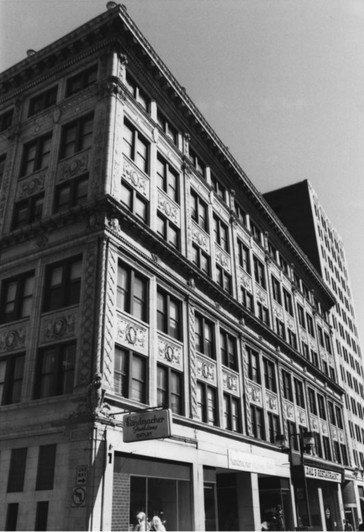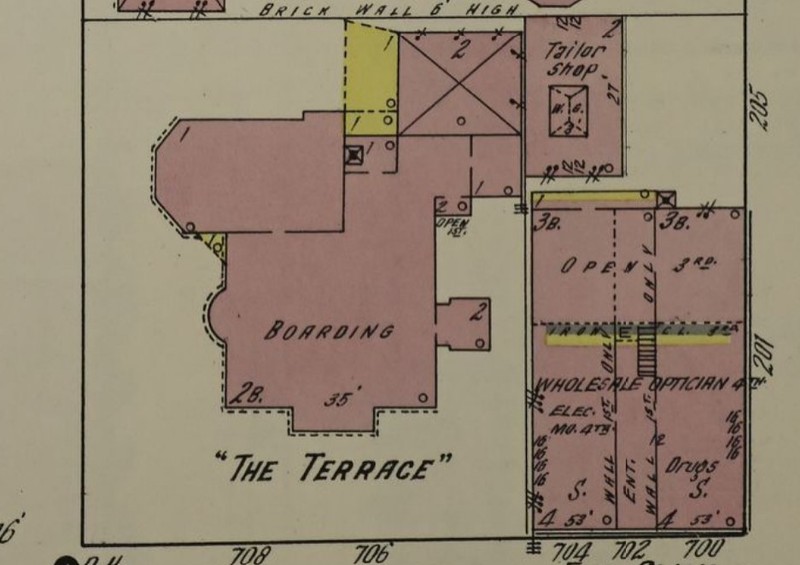Doctor's Building (Homewood Suites Nashville)
Introduction
Text-to-speech Audio
Constructed in 1916 as a three-story structure and known as the Doctor's Building owing to its original tenants, this Renaissance Revival Style was expanded in 1912 with an additional three stories. A local Vanderbilt University professor of Surgery, Dr. Matthew McGannon, had the building constructed under the design of Nashville architects Dougherty and Gardner. After his death in 1919, Dr. McGannon's widow sold the property to the Methodist Church South. By the mid-twentieth century, the number of physician's offices in the building dwindled but were replaced by government agencies. Doctor's Building became a listing in the National Register of Historic Places in 1985. The renovated building now contains a hotel, Homewood Suites.
Images
Front of Doctor's Building (Homewood Suites) in 2010 photo (smallbones)

Detail of 6th floor cornice, Doctor's Building, in 1985 photo for NRHP (Thomason & Associates)

Southeast facade of Doctor's Building in 1985, looking north, in NRHP photo (Thomason & Associates)

Future location of Doctor's Building: former Cole mansion ("The Terrace")/ boarding house on 1914 Sanborn map (V. 1 p. 6)

Backstory and Context
Text-to-speech Audio
Before the Doctor's Building was built, the site was occupied by the home of Colonel Edmund William Cole, a local railroad tycoon. The large, three-story home with two rear additions was turned into a boarding house called "The Terrace" by 1914 (see the Sanborn map image below). The mansion was torn down in 1916, shortly before construction began on the three-story Doctor's Building.
The Doctor's Building was designed for Dr. Matthew Charles McGannon. Dr. McGannon served as an officer in the Tennessee-Hermitage Bank. Dr. McGannon was an 1885 graduate of McGill U. in Montreal, Canada. He came to Nashville in 1895 from New York to accept the Professorship of Diseases of Women and Abdominal Surgery at the University College of Medicine, Nashville. He accepted a position as professor of surgery at Vanderbilt U. in 1912. By the 1910s, Dr. McGannon was chief surgeon of the Women's Hospital and an attending surgeon at both Vanderbilt and Nashville City Hospitals. Somewhere in his career, he found time to serve in the U.S. Army - likely in World War I. Shortly before his death in late 1919 at age 62 from heart disease, Dr. McGannon was appointed surgeon-general of Tennessee. Dr. McGannon's widow sold the property to the Board of Missions of the Methodist Episcopal Church South.
The Renaissance Revival Style Doctor's Building was designed by Edwin Dougherty and Thomas Gardner. The building features plentiful exterior decoration in glazed terra cotta tile: wreaths, swags, garlands, urns, lions, and shields based on the coat of arms of the Medici family (doctors from 15th-century Florence, Italy). The building is arranged around a large central stairwell. Around 1920 (probably when the three upper floors were added in 1921), the main entrance facing Church St. was redone in Carrara marble and glass blocks; above the entrance is the lettering "Doctor's Building" in a terra cotta panel.
Offices of the Nashville Academy of Medicine (NAM) were located in the Doctor's Building. Although the professional organization was organized in Nashville by seven physicians in 1821, it was chartered by the State of Tennessee in 1906 as the "Nashville Academy of Medicine & Davidson County Medical Society." The first female physician member joined NAM in 1901. Some of the NAM members who had offices in the Doctor's Building in the early 1920s were C.F. Anderson, Jere Caldwell, W.G. Kennon, John Lee, Eugene Orr, and Jack Witherspoon.
The now-six-story building was renamed the Lambuth Building in 1922 to honor Bishop Walter Lambuth, a doctor who was also a preacher and missionary before becoming a bishop. The Methodist Church owners had offices on the sixth floor. A trend began in the 1930s of physicians opening free-standing clinics throughout the city. NAM went on record in 1950 suggesting that soda pop and candy was not good for schoolchildren. Way back in the late 19th century they warned of the health consequences of smoking cigarettes! In 1954, NAM amended its charter and accepted its first African-American physician members the following year; the three were members of the faculty at Meharry. NAM moved its offices from the Lambuth (formerly Doctor's) Building in 1956 to Louise Avenue, where they stayed until 1975.
Many medical offices relocated to the suburbs and the Doctor's Building held few doctors or dentists by the late 1960s. The building gradually came to hold government offices of state agencies; the Tennessee Housing Development Agency occupied the upper five floors by 1985. The Doctor's Building was renovated in 2007 to 2008 to become a hotel. It now holds the Homewood Suites by Hilton with 121 rooms. One of the storefronts contained "Highway 65 Records." named for the fictional country music recording company from the former television series "Nashville."
Sources
Anonymous. News Items. The Chicago Medical Recorder. January 1st, 1895. 184 - 189.
Anonymous. Deaths. Journal of the American Medical Association, vol. 73, no. 18, 1378 - 1379. Published November 1st, 1919.
Nashville Downtown Partnership. Doctors' Building, Nashville Downtown Partnership: History and Architecture Tour. January 1st, 2022. Accessed August 17th, 2022. https://nashvilledowntown.com/go/doctors-building.
Nashville Academy of Medicine. Nashville Academy of Medicine Historical Timeline, Nashville Academy of Medicine. January 1st, 2022. Accessed August 18th, 2022. https://nashvillemedicine.org/timeline/.
Thomason, Philip. NRHP Nomination of Doctor's Building, Nashville, Tennessee. National Register. Washington, DC. National Park Service, 1985.
https://en.wikipedia.org/wiki/Doctor%27s_Building_(Nashville,_Tennessee)#/media/File:Doctors_Blg_Nashville.JPG
NPS: https://npgallery.nps.gov/AssetDetail/NRIS/85001607
National Park Service (NPS): https://npgallery.nps.gov/AssetDetail/NRIS/85001607
Library of Congress (LOC): https://www.loc.gov/item/sanborn08356_005/
